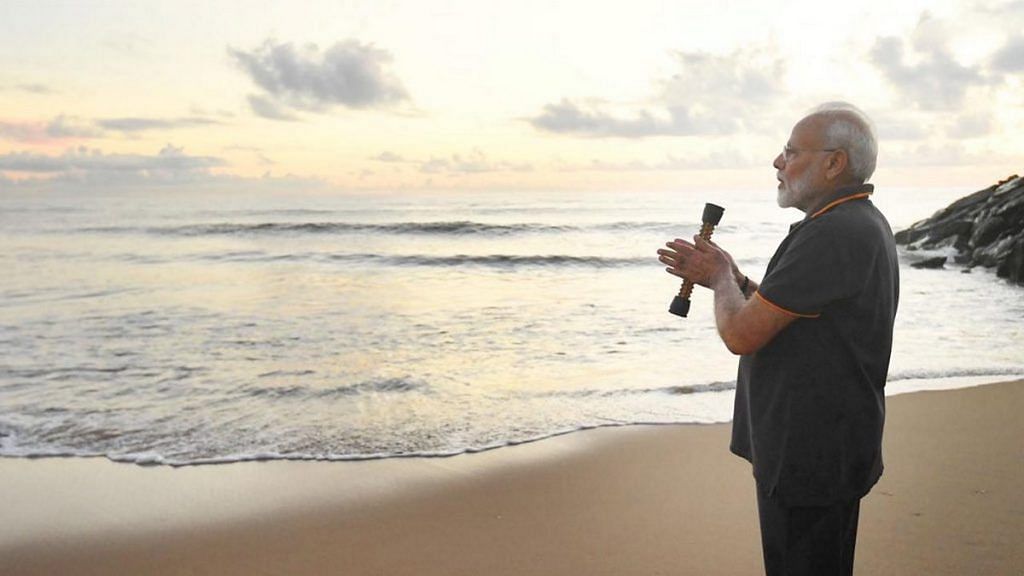Bangalore: Prime Minister Narendra Modi set social media abuzz last week when he went plogging on a beach at Mamallapuram, Tamil Nadu, to motivate citizens to be environmentally responsible.
But what aroused curiosity among people was an object he was holding while collecting waste from the beach Saturday. A day later, Modi ended all the curiosity and revealed that the object was an ‘acupressure roller’.
The tweet seems to be strategic too as Modi posted it after concluding his informal summit with Chinese President Xi Jinping in Mamallapuram.
Acupressure and its prickly cousin, acupuncture, originate from China. They are alternative therapies based on the principle of the flow of energy or ‘qi’ (pronounced “chi”) through the body via pathways called meridians.
Acupressure theory states that energy can get clogged and its flow prevented when there are blockages in these meridians. Using hands or devices to apply pressure to certain points on the body can relieve these blockages, restoring health and a balance of yin and yang (positive and negative energies).
But the theory, much like German-origin homeopathy, has been refuted by scientific studies.
Also read: From Wuhan spirit to Chennai vision, Modi-Xi agree differences shouldn’t dominate discourse
Bias in studies
Many studies that measured the effectiveness of acupressure and acupuncture show that the results from these treatments — when administered in the way as defined by traditional Chinese framework — are similar to those obtained with placebo.
The placebo treatment are “sham” controls — pressure is applied to random points on the body, not necessarily to the acu points that are supposed to be pressed. The same for acupuncture, where instead of acu points, needles are inserted at random points on the body.
But these studies are extremely difficult to double-blind, i.e., use the standard unbiased approach where neither the researchers nor the subjects know who is receiving the real treatment and who is being administered a placebo.
The researchers in such studies always end up knowing who is undergoing the sham treatment and who is being administered the acu treatment. Several studies that have shown positive outcomes are believed to be affected by this bias.
Such studies are often touted as proof that acupressure or acupuncture works, but since they aren’t fully double-blinded, there is a high risk of bias in their results.
Systematic reviews and meta studies involving acupressure and acupuncture show a positive result in pain relief, but they are accompanied by disclaimers that results are likely biased and not wholly representative of the true effects.
For acupressure, the most notable study was conducted in 2011. The researchers analysed 43 studies of randomised controlled trials and found that 35 of them showed the effectiveness of acupressure, but the authors concluded that the trials still didn’t prove efficacy and better-designed studies were needed.
For acupuncture, a 2012 meta analysis of 29 studies involving 18,000 patients concluded that it relieves pain, but the study was criticised heavily for bias. The researchers concluded that on a pain scale of 0 to 100, the subjects could tell a change of 5 points, which other scientists rebuffed.
Also read: What to expect on Day 2 of Modi & Xi’s Mamallapuram summit — trade, Huawei & Article 370
China has discarded acupuncture
Effectiveness of acupressure can be seen at times for superficial pain, of course, as any kind of massage and pressure can often relieve muscle stress and pain. Such practice is the basis of most sports medicine and physiotherapy today.
The Chinese themselves knew and understood the abstract and unscientific nature of acu treatments — acupuncture especially was dismissed as pseudoscience way back in the 1600s and abandoned, giving way to modern medicines that showed proven effectiveness.
But Chinese Communist Party leader Mao Zedong revived acupuncture in the 1950s to assuage people’s fears that the government had no plan for public health during the economic slump.
This is not to say that Traditional Chinese Medicine (TCM) is completely all nonsense. Much like parts of Ayurveda (as opposed to homeopathy), there are a few valuable treatments that are found in TCM that can supplement allopathy.
Tu Youyou, researcher and practitioner of TCM, won the 2015 Nobel Prize in medicine for her discovery of artemisinin (“qinghaosu”) and dihydroartemisinin, which are used to treat malaria and have saved millions of people.
Acupressure a supplement, not a replacement
However, with PM Modi now endorsing acupressure and the AYUSH Ministry having done so for a while, it is important to remember that these treatments are always supplemental if used in conjunction with other treatments and never as replacements.
Hand-held energy rollers are great to stimulate blood flow and relieve regular numbness, but are not medicinal treatments for disorders. Investing in proven treatments has a higher probability of fetching desired results.
Also read: India isn’t China’s economic or military equal but Mamallapuram lets Modi stand as tall as Xi
